Umrüstsätze für Elektrofahrräder sind eine beliebte Lösung für Radfahrer, die ihr herkömmliches Fahrrad mit Elektroantrieb aufrüsten möchten. Mit diesen Kits können Benutzer ihr Standardfahrrad in ein Elektrofahrrad (E-Bike) umwandeln, ohne ein komplett neues Fahrzeug kaufen zu müssen. Der Reiz von Umrüstsätzen liegt in ihrer Vielseitigkeit und Kosteneffizienz. So können Fahrer die Vorteile des Elektrofahrradfahrens genießen und gleichzeitig die Vertrautheit und den Komfort ihres vorhandenen Fahrrads beibehalten.
Die Kernkomponenten dieser Kits umfassen typischerweise einen Motor, eine Batterie, einen Controller und verschiedenes für die Installation erforderliches Zubehör. Der Motor ist das Herzstück des Umbausatzes und liefert die nötige Leistung zur Unterstützung des Fahrers. Er kann je nach gewähltem Kit an verschiedenen Stellen montiert werden, z. B. an der Vorderradnabe, der Hinterradnabe oder sogar am Mittelrahmen.
Der Akku versorgt den Motor mit Energie und ist oft wiederaufladbar, sodass längere Fahrten ohne häufige Stopps möglich sind. Controller regeln den Stromfluss zwischen Akku und Motor und sorgen für einen reibungslosen Betrieb und ein gutes Ansprechverhalten. Viele Kits verfügen zusätzlich über Funktionen wie Gashebel, Tretunterstützungssensoren und Displays, die Echtzeitinformationen zu Geschwindigkeit, Distanz und Akkustand liefern.
Die wichtigsten Erkenntnisse
- Umrüstsätze für Elektrofahrräder sind eine kostengünstige Möglichkeit, ein herkömmliches Fahrrad in ein Elektrofahrrad umzuwandeln und so die Vorteile einer motorisierten Unterstützung und einer höheren Geschwindigkeit zu nutzen.
- Bevor Sie sich für ein Umrüstkit entscheiden, sollten Sie Faktoren wie Fahrradtyp, gewünschte Geschwindigkeit und Reichweite, Motorleistung, Akkukapazität und Kompatibilität mit vorhandenen Fahrradkomponenten berücksichtigen.
- Es gibt drei Haupttypen von Umrüstsätzen für Elektrofahrräder: Vorderrad-, Hinterrad- und Mittelantriebssätze, jeder mit seinen eigenen Vorteilen und Überlegungen.
- Bei der Budgetplanung für den Umbau eines Elektrofahrrads sollten die Kosten für das Kit, zusätzliche Komponenten wie Akku und Ladegerät sowie gegebenenfalls die Kosten für die professionelle Installation berücksichtigt werden.
- Die ordnungsgemäße Installation und Wartung von E-Bike-Umrüstsätzen ist für Sicherheit und Leistung unerlässlich und erfordert möglicherweise grundlegende mechanische Kenntnisse oder professionelle Hilfe. Wählen Sie einen Umrüstsatz, der Ihren spezifischen Anforderungen und Wünschen entspricht, und berücksichtigen Sie dabei Faktoren wie Leistung, Reichweite und Kompatibilität mit Ihrem vorhandenen Fahrrad.
Zu berücksichtigende Faktoren vor der Auswahl eines Umrüstsatzes
Bei der Auswahl eines Umrüstsatzes für ein Elektrofahrrad müssen mehrere wichtige Faktoren berücksichtigt werden, um Kompatibilität und Leistung zu gewährleisten. Eine der wichtigsten Überlegungen ist der Typ des umzubauenden Fahrrads. Verschiedene Fahrräder haben unterschiedliche Rahmengeometrien, Radgrößen und Bremssysteme, was die Wahl des Motortyps und des Montageorts beeinflussen kann.
Ein Mountainbike benötigt beispielsweise möglicherweise einen robusteren Motor für unwegsames Gelände, während bei einem Pendlerrad Effizienz und leichte Komponenten im Vordergrund stehen. Ein weiterer wichtiger Faktor ist die Motorleistung. Die Leistung von E-Bike-Motoren wird üblicherweise in Watt angegeben, wobei gängige Optionen zwischen 250 W und 1500 W oder mehr liegen.
Eine höhere Wattzahl bedeutet in der Regel mehr Geschwindigkeit und bessere Steigfähigkeit, kann aber auch zu einem höheren Akkuverbrauch führen. Fahrer sollten ihre typischen Fahrbedingungen – wie Gelände und Distanz – berücksichtigen, um die passende Leistungsstufe für ihre Bedürfnisse zu bestimmen. Darüber hinaus sollten lokale Vorschriften zu den Leistungsgrenzen von E-Bikes beachtet werden, da in einigen Regionen die Motorleistung für den legalen Straßenverkehr begrenzt ist.
Arten von Umrüstsätzen für Elektrofahrräder

Umrüstsätze für Elektrofahrräder lassen sich je nach Design und Einbauart in verschiedene Typen unterteilen. Nabenmotor-Kits gehören zu den gängigsten und beinhalten den Einbau eines Motors in die Vorder- oder Hinterradnabe. Diese Art von Kit ist relativ einfach zu installieren und bietet eine saubere Optik, da der Motor im Rad verborgen ist.
Nabenmotoren sind in verschiedenen Leistungsstufen erhältlich und bieten ausreichend Unterstützung für die meisten Anforderungen im Stadtverkehr. Eine weitere beliebte Option sind Mittelmotor-Umrüstsätze, bei denen der Motor am Tretlager des Fahrrads montiert wird. Diese Konfiguration ermöglicht eine bessere Gewichtsverteilung und verbesserte Leistung an steilen Steigungen, da Mittelmotoren die Gänge des Fahrrads für ein höheres Drehmoment nutzen.
Die Installation dieser Kits kann jedoch komplexer sein und zusätzliche Modifikationen am Antriebsstrang des Fahrrads erfordern. Zudem sind Mittelantriebssysteme tendenziell effizienter als Nabenmotoren, insbesondere in hügeligem Gelände. Eine weitere neue Kategorie ist der Reibungsantrieb, bei dem ein kleiner Motor gegen den Reifen drückt und so für Vortrieb sorgt.
Diese Kits sind zwar oft weniger leistungsstark als Naben- oder Mittelantriebsoptionen, aber sie sind leicht und können bei Nichtgebrauch einfach entfernt werden. Diese Flexibilität macht sie für Fahrer attraktiv, die gelegentlich etwas mehr Leistung wünschen, ohne ihr Fahrrad dauerhaft zu verändern.
Budgetierung für die Umrüstung Ihres Elektrofahrrads
| Kosten |
Kosten |
| Umrüstsatz für Elektrofahrräder |
500 |
| Batterie |
300 |
| Ladegerät |
50 |
| Werkzeuge |
100 |
| Zubehör (Lichter, Schutzbleche usw.) |
150 |
| Arbeitskosten (bei Beauftragung eines Fachmanns) |
200 |
| Gesamt |
1300 |
Bei der Budgetplanung für den Umbau eines Elektrofahrrads geht es nicht nur um die Anschaffungskosten des Umbausatzes selbst, sondern auch um zusätzliche Kosten, die bei Installation und Wartung entstehen können. Die Preisspanne für Umbausätze kann je nach Faktoren wie Motorleistung, Akkukapazität und Markenbekanntheit stark variieren. Basissätze beginnen bei etwa 300 TP8T, während Hochleistungsmodelle über 1.500 TP8T kosten können.
Fahrer sollten auch mögliche Kosten für Werkzeug oder professionelle Installation einkalkulieren, wenn sie den Umbau nicht selbst durchführen möchten. Zusätzlich zu den Anschaffungskosten sind auch laufende Wartungskosten zu erwarten. E-Bike-Komponenten müssen im Laufe der Zeit regelmäßig gewartet oder ausgetauscht werden, insbesondere Akkus, die typischerweise eine Lebensdauer von 500 bis 1.000 Ladezyklen haben.
Fahrer sollten auch in Zubehör wie verbesserte Bremsen oder Reifen investieren, die den höheren Geschwindigkeiten beim E-Biken gewachsen sind. Darüber hinaus können in bestimmten Ländern Versicherungs- oder Anmeldegebühren anfallen, die das Gesamtbudget zusätzlich belasten.
Installation und Wartung von Umrüstsätzen für Elektrofahrräder
Der Installationsprozess von E-Bike-Umrüstsätzen kann je nach gewähltem Kit und den mechanischen Fähigkeiten des Fahrers stark variieren. Viele Hersteller bieten detaillierte Anleitungen oder Video-Tutorials an, die den Benutzer durch den Installationsprozess führen. Wer lieber selbst Hand anlegt, benötigt in der Regel grundlegende Werkzeuge wie Schraubenschlüssel, Schraubendreher und Reifenheber.
Es ist jedoch wichtig, vor der Installation sicherzustellen, dass alle Komponenten mit dem vorhandenen Fahrrad kompatibel sind. Die Wartung eines umgebauten E-Bikes umfasst regelmäßige Überprüfungen wichtiger Komponenten wie Akku, Motor und Kabelverbindungen. Fahrer sollten den Zustand des Akkus überwachen, indem sie die Ladezyklen verfolgen und sicherstellen, dass die Anschlüsse sauber und sicher bleiben.
Darüber hinaus sind regelmäßige Inspektionen mechanischer Teile wie Bremsen und Schaltung unerlässlich, um die Sicherheits- und Leistungsstandards einzuhalten. Manche Fahrer investieren in regelmäßige professionelle Wartungen, um sicherzustellen, dass ihr E-Bike in optimalem Zustand bleibt.
Auswahl des richtigen Umrüstsatzes für Elektrofahrräder für Ihre Bedürfnisse

Fahrstil und Leistung
Fahrer sollten zunächst ihre primären Einsatzzwecke – ob Pendeln, Freizeitfahren oder anspruchsvolles Gelände – bewerten und die passende Motorleistung und Batteriekapazität wählen. Pendler, die häufig in der Stadt unterwegs sind, können beispielsweise von einem leichten Nabenmotor-Kit profitieren, das schnelle Beschleunigung und einfache Manövrierbarkeit bietet.
Budget und Zuverlässigkeit
Fahrer sollten ihr Budget berücksichtigen und Leistungsmerkmale und Kosten gegeneinander abwägen. Es mag verlockend sein, sich für ein günstigeres Kit zu entscheiden. Die Investition in eine renommierte Marke mit positiven Bewertungen kann jedoch langfristig zu mehr Zufriedenheit und Zuverlässigkeit führen. Auch die Kompatibilität mit vorhandenen Fahrradkomponenten sollte nicht außer Acht gelassen werden. Wenn Bremsen, Reifen und Rahmengeometrie zum gewählten Kit passen, erleichtert dies die Installation.
Persönliche Vorlieben und Ästhetik
Letztendlich spielen auch persönliche Vorlieben in Bezug auf Ästhetik und Funktionalität eine Rolle bei der Entscheidungsfindung. Manche Fahrer legen Wert auf schlanke Designs, die sich nahtlos in ihr Fahrrad einfügen, während andere nach Kits mit erweiterten Funktionen wie Smartphone-Konnektivität oder anpassbaren Einstellungen suchen. Unter Berücksichtigung all dieser Faktoren – Fahrstil, Budget, Kompatibilität und persönliche Vorlieben – können Radfahrer fundierte Entscheidungen treffen und ihr Fahrerlebnis durch Elektro-Umrüstkits verbessern.
FAQs
Was ist ein Umrüstsatz für Elektrofahrräder?
Ein Umbausatz für Elektrofahrräder ist ein Satz von Komponenten, die an einem normalen Fahrrad angebracht werden können, um es in ein Elektrofahrrad umzuwandeln. Er enthält in der Regel einen Motor, eine Batterie, einen Controller und andere notwendige Teile.
Welche Vorteile bietet die Verwendung eines Umrüstsatzes für Elektrofahrräder?
Mit einem E-Bike-Umrüstsatz können Sie Ihr vorhandenes Fahrrad zu einem Elektrofahrrad aufrüsten. Es unterstützt Sie beim Treten und erleichtert Ihnen das Bewältigen von Hügeln und längeren Strecken. Es ist außerdem eine günstigere Option im Vergleich zum Kauf eines neuen E-Bikes.
Wie wähle ich das richtige Umrüstkit für ein Elektrofahrrad aus?
Berücksichtigen Sie bei der Auswahl des richtigen E-Bike-Umbausatzes Faktoren wie Ihren Fahrradtyp, den gewünschten Unterstützungsgrad, die benötigte Reichweite und Ihr Budget. Achten Sie darauf, dass der Umbausatz mit Ihrem Fahrrad kompatibel ist und Ihren spezifischen Anforderungen entspricht.
Welche verschiedenen Arten von Umrüstsätzen für Elektrofahrräder gibt es?
Es gibt verschiedene Arten von Umrüstsätzen für Elektrofahrräder, darunter Vorderrad-, Hinterrad- und Mittelantriebssätze. Vorderradsätze sind einfacher zu montieren, während Hinterrad- und Mittelantriebssätze eine bessere Balance und Leistung bieten. Jeder Typ hat seine eigenen Vorteile und Überlegungen.
Worauf sollte ich bei einem hochwertigen Umrüstsatz für Elektrofahrräder achten?
Achten Sie bei der Auswahl eines hochwertigen E-Bike-Umbausatzes auf einen zuverlässigen Motor, einen langlebigen Akku, langlebige Komponenten und eine renommierte Marke mit gutem Kundenservice. Achten Sie auch auf die Garantie und den Kundendienst des Herstellers.
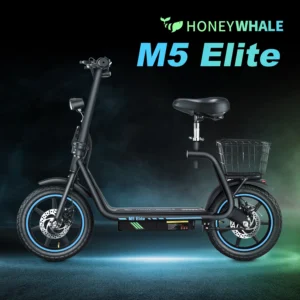 HONEYWHALE M5 Elite Elektroroller für Erwachsene mit Sitz, Peak 750-W-Motor, 45 km maximale Reichweite, 40 km/h, 14-Zoll-Reifen, 48-V-13-Ah-Batterie, EScooter
2 × 897,70 €
HONEYWHALE M5 Elite Elektroroller für Erwachsene mit Sitz, Peak 750-W-Motor, 45 km maximale Reichweite, 40 km/h, 14-Zoll-Reifen, 48-V-13-Ah-Batterie, EScooter
2 × 897,70 € 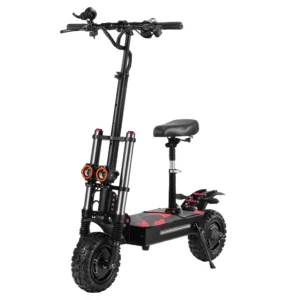 BOYUEDA S3-11 Elektroroller, 6000 W, leistungsstarker Doppelmotor, 60 V, 38 Ah Akku, 120 km maximale Reichweite, 85 km/h Geschwindigkeit, faltbarer E-Scooter für Erwachsene
2 × 2 281,37 €
BOYUEDA S3-11 Elektroroller, 6000 W, leistungsstarker Doppelmotor, 60 V, 38 Ah Akku, 120 km maximale Reichweite, 85 km/h Geschwindigkeit, faltbarer E-Scooter für Erwachsene
2 × 2 281,37 €  VD61 Display für Bafang Mittelmotor CAN Bus E-Bike Display Kompatibel mit M625 M325 M225 M200 M400 M500 M600 M620 M420 M510
1 × 88,30 €
VD61 Display für Bafang Mittelmotor CAN Bus E-Bike Display Kompatibel mit M625 M325 M225 M200 M400 M500 M600 M620 M420 M510
1 × 88,30 € 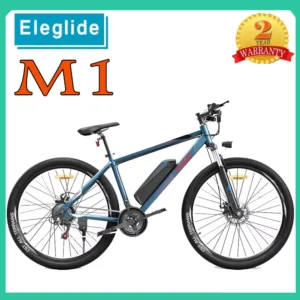 ELEGLIDE M1 Elektrofahrrad für Erwachsene, verbesserte Version, 27,5 Zoll, Mountainbike, 250 W, bürstenloser Hall-Motor, Shimano-Schalthebel, 21 Zoll
1 × 974,95 €
ELEGLIDE M1 Elektrofahrrad für Erwachsene, verbesserte Version, 27,5 Zoll, Mountainbike, 250 W, bürstenloser Hall-Motor, Shimano-Schalthebel, 21 Zoll
1 × 974,95 € 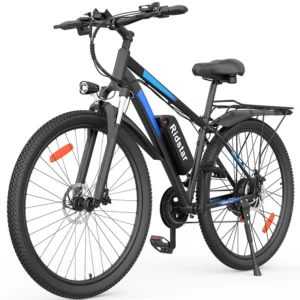 Ridstar S29PRO 1000W 48V 15Ah 30-50km/h >60km 29" Electric Bicycle
1 × 1 006,96 €
Ridstar S29PRO 1000W 48V 15Ah 30-50km/h >60km 29" Electric Bicycle
1 × 1 006,96 €  Electrib E5B 6000W 60V 40Ah 85km/h 150Km 11" Zweirad-Elektroroller
1 × 1 236,31 €
Electrib E5B 6000W 60V 40Ah 85km/h 150Km 11" Zweirad-Elektroroller
1 × 1 236,31 €  Isinwheel S9 Max Elektroroller für Erwachsene, 36 V, 10,4 Ah Akku, 30–40 km, maximale Reichweite, 500-W-Motor, 30 km/h, faltbar, Smart-App, Escooter
1 × 593,26 €
Isinwheel S9 Max Elektroroller für Erwachsene, 36 V, 10,4 Ah Akku, 30–40 km, maximale Reichweite, 500-W-Motor, 30 km/h, faltbar, Smart-App, Escooter
1 × 593,26 € 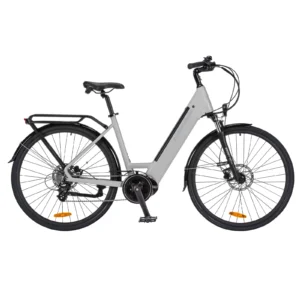 Damen Ebike eCity 43,2 V 250 W M200 Mittelmotor City Ebike Pedelec, 12 Ah Akku, 8 Gänge,
1 × 1 180,46 €
Damen Ebike eCity 43,2 V 250 W M200 Mittelmotor City Ebike Pedelec, 12 Ah Akku, 8 Gänge,
1 × 1 180,46 € 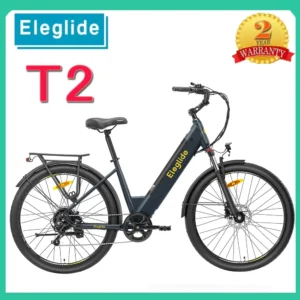 Eleglide T2 27,5 Zoll Elektrofahrrad für Erwachsene, 250-W-Motor, 36 V, 13 Ah, 100 km Reichweite, mit hydraulischen Scheibenbremsen, 25 km/h Elektrofahrrad
1 × 1 269,45 €
Eleglide T2 27,5 Zoll Elektrofahrrad für Erwachsene, 250-W-Motor, 36 V, 13 Ah, 100 km Reichweite, mit hydraulischen Scheibenbremsen, 25 km/h Elektrofahrrad
1 × 1 269,45 € 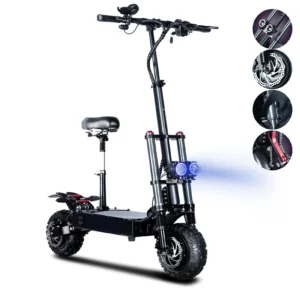 X10 Elektroroller, X10, 6000 W, 60 V, 40 Ah, 75–85 km/h, 60–100 km, 11-Zoll-Offroad-Scooter
1 × 1 404,01 €
X10 Elektroroller, X10, 6000 W, 60 V, 40 Ah, 75–85 km/h, 60–100 km, 11-Zoll-Offroad-Scooter
1 × 1 404,01 € 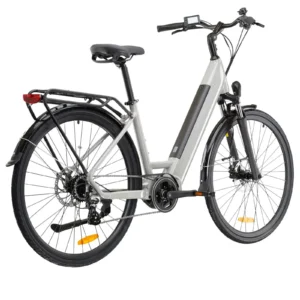 E-Bike City Bike, Elektrofahrrad, 43 V 12 Ah Akku, bis zu 150 km Reichweite, 28 Zoll Rahmengröße, 250 W Motor, max. 25 km/h
1 × 1 179,71 €
E-Bike City Bike, Elektrofahrrad, 43 V 12 Ah Akku, bis zu 150 km Reichweite, 28 Zoll Rahmengröße, 250 W Motor, max. 25 km/h
1 × 1 179,71 € 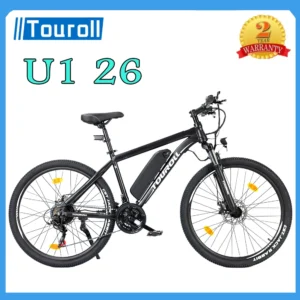 Touroll U1 26 Elektrofahrrad für Erwachsene, 26 Zoll, 250-W-Motor, 13 Ah, herausnehmbarer Lithium-Ionen-Akku, 21-Gang-MTB-Fahrrad, elektrisches Mountainbike
1 × 819,95 €
Touroll U1 26 Elektrofahrrad für Erwachsene, 26 Zoll, 250-W-Motor, 13 Ah, herausnehmbarer Lithium-Ionen-Akku, 21-Gang-MTB-Fahrrad, elektrisches Mountainbike
1 × 819,95 € 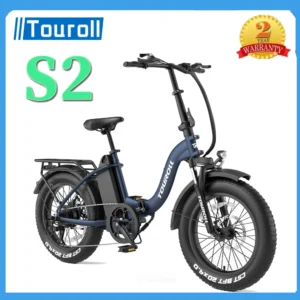 Touroll S2 Fahrräder für Erwachsene, 20 Zoll, 250-W-Motor, Elektrofahrräder, 25 km/h, 720-Wh-Akku, 120 km Reichweite, 48 V, 15 Ah, Elektrofahrräder
2 × 1 269,45 €
Touroll S2 Fahrräder für Erwachsene, 20 Zoll, 250-W-Motor, Elektrofahrräder, 25 km/h, 720-Wh-Akku, 120 km Reichweite, 48 V, 15 Ah, Elektrofahrräder
2 × 1 269,45 € 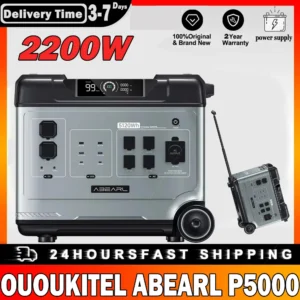 OUKITEL ABEARL P5000 Solargenerator Tragbares Kraftwerk 5120Wh 2200W Ausgang Nahtlose 2000W USV-Ladestationen
1 × 2 426,59 €
OUKITEL ABEARL P5000 Solargenerator Tragbares Kraftwerk 5120Wh 2200W Ausgang Nahtlose 2000W USV-Ladestationen
1 × 2 426,59 €  KuKirin G4 Max 3200W 60V 35,2Ah 86km/h 95Km 12" Offroad-Elektroroller
1 × 2 789,56 €
KuKirin G4 Max 3200W 60V 35,2Ah 86km/h 95Km 12" Offroad-Elektroroller
1 × 2 789,56 € 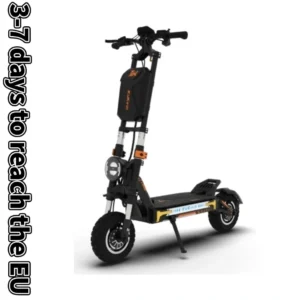 Kukirin G4 Max, G4 Max, 3200 W, 60 V, 35,2 Ah, 86 km/h, 95 km, 12 Zoll Elektroroller mit Doppelmotor
1 × 2 789,56 €
Kukirin G4 Max, G4 Max, 3200 W, 60 V, 35,2 Ah, 86 km/h, 95 km, 12 Zoll Elektroroller mit Doppelmotor
1 × 2 789,56 € 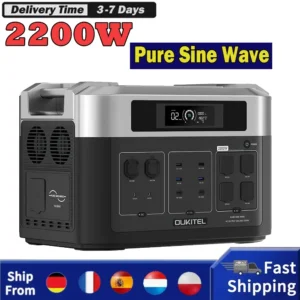 OUKITEL BP2000 Tragbare Powerstation 2048Wh/640000mAh LiFePO4-Akku 2200W AC-Ausgang Solargenerator Ladestationen
1 × 1 494,65 €
OUKITEL BP2000 Tragbare Powerstation 2048Wh/640000mAh LiFePO4-Akku 2200W AC-Ausgang Solargenerator Ladestationen
1 × 1 494,65 € 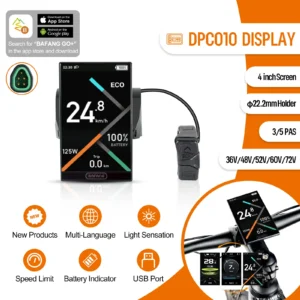 Bafang DPC010 CAN-Protokoll-Display 4,0-Zoll-Bildschirm Bluetooth-Tachometer für Bafang Mittelmotor-Kits 0-5-Stufen-Unterstützung
1 × 136,51 €
Bafang DPC010 CAN-Protokoll-Display 4,0-Zoll-Bildschirm Bluetooth-Tachometer für Bafang Mittelmotor-Kits 0-5-Stufen-Unterstützung
1 × 136,51 € 


